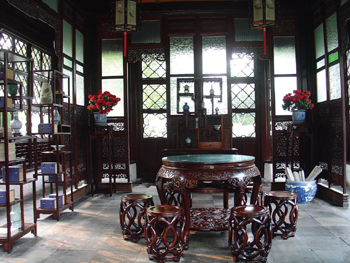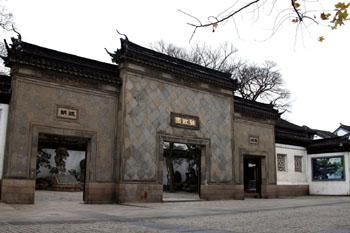Written by: Luo Zhenwen
Posted on: October 24, 2012 |  | 中文
| 中文
The Humble Administrator's Garden is a remarkable private garden in southern China. Situated in the north-eastern part of the city of Suzhou, it was built in the Zhengde Period (1506-152I) of the Ming Dynasty. The garden is divided into eastern, central and western parts, which together constitute 4.1 hectares in area, quite a large area as far as private gardens go. The central and western sections have retained their original appearance to date, whereas the eastern part has been remodeled into a new garden. Although the current Humble Administrator's Garden is not quite the same as the one in the Ming Dynasty, it still serves as a good example of ancient Chinese private gardens.
The central part of the Humble Administrator's Garden is the main garden area, and in terms of overall planning, this part can be divided into the northern water area and the southern land area, each of which takes up half of the total space. The southern area is where most of the architecture is centered, and where all the major halls, principal rooms, towers and houses are located. In terms of scenic areas, this part can be divided into three portions from east to west, with the central part being the most important. The Yuanxiang (Distant Fragrance) Hall at the center of the garden is the largest hall of the entire place. Built facing the water, it has a wide, open terrace at the north from where the best view of the lotus presents a feast for the eyes. It is decorated with French doors, and through these windows the hills and waters can be seen undulating like a scroll of scenic paintings.
 The eastern area is composed of a number of constructions, such as Haitang Chun Wu (Spring Crabapple Flower Dock) and the Linglong House (Exquisite Garden), etc. It is an area enclosed within walls and artificial hills, with loquat trees planted within, giving it the name, the "Loquat Garden". The western area holds the Yulan Tang (Magnolia Hall), Dezhen (Attainment of Truth) Pavilion and Xiangzhou (Fragrant Islet) Stone Bridge inside an open courtyard space formed by corridors and artificial hills.
The eastern area is composed of a number of constructions, such as Haitang Chun Wu (Spring Crabapple Flower Dock) and the Linglong House (Exquisite Garden), etc. It is an area enclosed within walls and artificial hills, with loquat trees planted within, giving it the name, the "Loquat Garden". The western area holds the Yulan Tang (Magnolia Hall), Dezhen (Attainment of Truth) Pavilion and Xiangzhou (Fragrant Islet) Stone Bridge inside an open courtyard space formed by corridors and artificial hills.
The central part of the Humble Administrator's Garden is mainly a scenic area of open waters, with complimentary architectural scenes. The water and the architecture together form a garden area of infinite beauty. The northern area of the garden is the water scene area, and built within the water are two islets on which hills are built with earth and stone. On the western islet at the top of the hill is built the Fragrant Snow and Clouds Pavilion. On the western end of the islet there is a pavilion named "Lotus Breeze from all Sides". Viewed from above, it rises out of the water with upturned eaves, like a pearl surrounded with a pond full of lotuses. On the eastern islet there is the Pavilion of the Northern Hills. Flat bridges are built between the two islets and between each islet and the water bank. The bridges serve for the convenience of the tourists and also add to the variety and coherence of the water scenes. The northwest central part, has a variety of architectural forms, including halls, mansions, pavilions and stone bridges interspersed with corridors, bridges and artificial hills decorated with crabapple flower trees and loquat trees. The garden scenes therefore give no sense of monotony, but rather a sense of richness and diversity.
The western part of the Humble Administrator's Garden is only half the size of the central part, and is also mainly an area of water scenery. The pond runs from north to south, and in the central part, where the water widens, an islet has been built. The surface of the water is shaped like a narrow carpenter's square. The main sceneries are concentrated at the northern part. At this end, there is a Tower of Water Reflection, decorated with exquisitely-made long windows on the side facing the water and between the columns. Through these windows one is able to view pleasing scenes from the reflections on the surface. An observer can catch the moon in the water, and see clouds floating on the pond surface, all from the glittering ripples.
 At the opposite end of the pond is built the House of 36 Mandarin Ducks. Looking out through one of the windows in summer, one can see lotuses swaying gently to and fro in the pond and mandarin ducks playing in the water. A long corridor appears to lie delicately afloat on the water, reflecting the beauty of the walls that divide the central and western parts of the garden. The Liuting Pavilion looks like an abstract ship hull inside, and lotus fills the entire pond.
At the opposite end of the pond is built the House of 36 Mandarin Ducks. Looking out through one of the windows in summer, one can see lotuses swaying gently to and fro in the pond and mandarin ducks playing in the water. A long corridor appears to lie delicately afloat on the water, reflecting the beauty of the walls that divide the central and western parts of the garden. The Liuting Pavilion looks like an abstract ship hull inside, and lotus fills the entire pond.
The Humble Administrator's Garden has a water area which extends over three fifths of its entire area. The Fragrant Islet Stone Bridge is beautifully shaped. Standing at the ship head, one can see ripples reflecting the light and brightness all around, reminding one of the old days when painted stone bridges were a popular feature in architecture. Rich vegetation is planted inside the garden in great variety, forming several scenic spots where plants and flowers are the theme and visual focus. In early spring, plum flowers at the Fragrant Snow and Clouds Pavilion blossom against the cold, and crabapple flowers at the Spring Crabapple Flower Dock weave a brocade of colors. In summer at the Jiashi Pavilion, the loquat trees are laden with golden fruit. In autumn, the fragrance of the rice flowers wafts into the Fragrant Sorghum Wind House. And in winter, pine and bamboo trees at the Pine Wind and Water Pavilion keep their green in the cold. The Tower of Viewing the Mountain allows one to feast the eye, the Distant Fragrance Hall invigorates one's sense of smell, and the Rain Listening Hall pleases the ears with the sound of raindrops falling on banana leaves.
The current Humble Administrator's Garden, in comparison with the original one, has had several buildings and islets added to it. Although the scenes might seem to lack in a natural, more open and lofty feel, the garden is still a masterpiece of meticulous work.
You may also like: